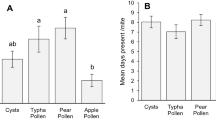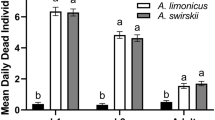Abstract
A two-year study was conducted in a citrus orchard, Citrus sinensis L., to determine frequency of predation on glassy-winged sharpshooter (GWSS), Homalodisca vitripennis (Germar). A total of 1,578 arthropod predators, representing 18 taxa, were collected and assayed for the presence of GWSS egg protein by an enzyme-linked immunosorbent assay using a Homalodisca-species and egg-specific monoclonal antibody and then by polymerase chain reaction using a H. vitripennis-specific DNA marker. The gut content analyses revealed the presence of GWSS remains in the gut of 2.28 % of the total arthropod predator population, with 3.09 % of the spiders and 0.59 % of the insect predators testing positive. Moreover, a comparison of the two assays indicated that they were not equally effective at detecting GWSS remains in predator guts. Low frequencies of GWSS detection in the gut of predators indicated that GWSS are not a primary prey and that predators may contribute little to suppression of this pest in citrus.
Similar content being viewed by others
References
Aebi A, Brown PMJ, De Clercq P, Hautier L, Howe A, Ingels B, Ravn HP, Sloggett JJ, Zindel R, Thomas A (2011) Detecting arthropod intraguild predation in the field. BioControl 56:429–440
Agustí N, de Vincente MC, Gabarra R (1999) Development of sequence amplified characterized region (SCAR) markers of Helicoverpa armigera: a new polymerase chain reaction-based technique for predator gut analysis. Mol Ecol 8:1467–1474
Almeida RPP, Purcell AH (2003) Transmission of Xylella fastidiosa to grapevines by Homalodisca coagulata (Hemiptera: Cicadellidae). J Econ Entomol 96:264–271
Blua MJ, Phillips PA, Redak RA (1999) A new sharpshooter threatens both crops and ornamentals. Calif Agric 53:22–25
California Department of Food and Agriculture (CDFA) (2006) County agricultural commissioner’s data, calendar year 2005. California Department of Food and Agriculture, Sacramento, USA
Chang CJ, Garnier M, Zreik L, Rossetti V, Bové JM (1993) Culture and serological detection of Xylella fastidiosa, the xylem-limited bacterium associated with citrus variegated chlorosis disease. In: Moreno LWTP, da Graça JV (eds) Proceedings of the 12th conference of the international organization of citrus virologists, New Delhi. University of California, Riverside, USA, pp 294–300
Chen Y, Giles KL, Payton ME, Greenstone MH (2000) Identifying key cereal aphid predators by molecular gut analysis. Mol Ecol 9:1887–1898
Costello MJ, Daane KM (1999) Abundance of spiders and insect predators on grapes in central California. J Arachnol 27:531–538
Damsteegt VD, Brlansky RH, Phillips PA, Roy A (2006) Transmission of Xylella fastidiosa, causal agent of citrus variegated chlorosis, by the glassy-winged sharpshooter, Homalodisca coagulata. Plant Dis 90:567–570
Davis MJ, Purcell AH, Thompson SV (1978) Pierce’s disease of grapevines: isolation of the causal bacterium. Science 199:75–77
de León JH, Fournier V, Hagler JR, Daane KM (2006) Development of molecular diagnostic markers for the glassy-winged sharpshooter Homalodisca coagulata (Homoptera: Cicadellidae) for use in predator gut content examinations. Entomol Exp Appl 119:109–119
Fournier V, Hagler JR, Daane KM, de León JH, Groves RL, Costa HS, Henneberry TJ (2006) Development and application of glassywinged and smoke-tree sharpshooter egg-specific predator gut content ELISA. Biol Control 37:108–118
Fournier V, Hagler JR, Daane KM, de León JH, Groves RL (2008) Identifying the predator complex of Homalodisca vitripennis (Hemiptera: Cicadellidae): a comparative study of the efficacy of an ELISA and PCR gut content assay. Oecologia 157:629–640
Greenstone MH (1983) Site-specificity and site tenacity in a wolf-spider: a serological dietary analysis. Oecologia 56:79–83
Greenstone MH (1996) Serological analysis of arthropod predation: past, present, and future. In: Symondson WOC, Liddell JE (eds) The ecology of agricultural pests. Chapman and Hall, New York, USA, pp 383–399
Greenstone MH, Morgan CE (1989) Predation on Heliothis zea (Lepidoptera: Noctuididae): an instar specific ELISA assay for stomach analysis. Ann Entomol Soc Am 82:45–49
Greenstone MH, Shufran KA (2003) Spider predation: species-specific identification of gut contents by polymerase chain reaction. J Arachnol 31:131–134
Hagler JR (2006) Development of an immunological technique for identifying multiple predator-prey interactions in a complex arthropod assemblage. Ann Appl Biol 149:153–165
Hagler JR (2011) An immunological approach to quantify consumption of protein-tagged Lygus hesperus by the entire cotton predator assemblage. Biol Control 58:337–345
Hagler JR, Naranjo SE (1997) Measuring the sensitivity of an indirect predator gut content ELISA: detectability of prey remains in relation to predator species, temperature, time, and meal size. Biol Control 9:112–119
Hagler JR, Cohen AC, Enriquez FJ, Bradley-Dunlop D (1991) An egg-specific monoclonal antibody to Lygus hesperus. Biol Control 1:75–80
Hagler JR, Brower AG, Tu Z, Byrne DN, Bradley-Dunlop D, Enriquez FJ (1993) Development of a monoclonal antibody to detect predation of the sweetpotato whitefly, Bemisia tabaci. Entomol Exp Appl 68:231–236
Hagler JR, Naranjo SE, Bradley-Dunlop D, Enriquez FJ, Henneberry TJ (1994) A monoclonal antibody to pink bollworm (Lepidoptera: Gelechiidae) egg antigen: a tool for predator gut analysis. Ann Entomol Soc Am 87:85–90
Harper GL, King RA, Dodd C, Harwood JD, Glen DM, Bruford MW, Symondson WOC (2005) Rapid screening of invertebrate predators for multiple prey DNA targets. Mol Ecol 14:819–827
Harwood JD, Phillips SW, Sunderland KD, Symondson WOC (2001) Secondary predation: quantification of food chain errors in an aphid–spider–carabid system using monoclonal antibodies. Mol Ecol 10:2049–2057
Harwood JD, Sunderland KD, Symondson WOC (2004) Prey selection by linyphiid spiders: molecular tracking of the effects of alternative prey on rates of aphid consumption in the field. Mol Ecol 13:3549–3560
Harwood JD, Bostrom MR, Hladilek EE, Wise DH, Obrycki JJ (2007a) An order-specific monoclonal antibody to Diptera reveals the impact of alternative prey on spider feeding behavior in a complex food web. Biol Control 41:397–407
Harwood JD, Desneux N, Yoo HJS, Rowley DL, Greenstone MH, Obrycki JJ, O’Neil RJ (2007b) Tracking the role of alternative prey in soybean aphid predation by Orius insidiosus: a molecular approach. Mol Ecol 16:4390–4400
Hix R, Toscano N, Gispert C (2003) Area-wide management of the glassy-winged sharpshooter in the Temecula and Coachella Valleys. In: Tariq MA, Oswalt S, Blincoe P, Spencer R, Houser L, Ba A, Esser T (eds) Proceedings, 2003 Pierce’s disease research symposium. California Department of Food and Agriculture, Coronado, CA, 8–11 December 2003. Copeland Printing, Sacramento, USA, pp 292–294
Irvin NA, Hoddle MS (2005a) The competitive ability of three mymarid egg parasitoids (Gonatocerus spp.) for glassy-winged sharpshooter (Homalodisca coagulata) eggs. Biol Control 34:204–214
Irvin NA, Hoddle MS (2005b) Determination of Homalodisca coagulata (Hemiptera: Cicadellidae) egg ages suitable for oviposition by Gonatocerus ashmeadi, Gonatocerus triguttatus, and Gonatocerus fasciatus (Hymenoptera: Mymaridae). Biol Control 32:391–400
Krugner R, Groves RL, Johnson MW, Flores AP, Hagler JR, Morse JG (2009) Seasonal population dynamics of Homalodisca vitripennis (Hemiptera: Cicadellidae) in sweet orange trees maintained under continuous deficit irrigation. J Econ Entomol 102:960–973
Park YL, Perring TM, Farrar CA, Gispert C (2006) Spatial and temporal distribution of two sympatric Homalodisca spp. (Hemiptera: Cicadellidae): implications for areawide pest management. Agric Ecosyst Environ 113:168–174
Perring TM, Farrar CA, Blua MJ (2001) Proximity to citrus influences Pierce’s disease in Temecula Valley vineyards. Calif Agric 55:13–18
Purcell AH, Saunders SR (1999) Glassy-winged sharpshooter expected to increase plant disease. Calif Agric 53:26–27
Riechert SE, Bishop L (1990) Prey control by an assemblage of generalist predators: spiders in garden test systems. Ecology 71:1441–1450
Riechert SE, Lockley T (1984) Spiders as biological control agents. Annu Rev Entomol 29:299–320
Sorensen JT, Gill RJ (1996) A range extension of Homalodisca coagulata (Say) (Hemiptera: Clypeorrhyncha: Cicadellidae) to southern California. Pan-Pac Entomol 72:160–161
Symondson WOC, Liddell JE (1996) A species-specific monoclonal antibody system for detecting the remains of field slugs, Deroceras reticulatum (Mueller) (Mollusca: Pulmonata), in carabid beetles. Biocontrol Sci Technol 6:91–99
Triapitsyn SV, Mizell RF, Bossart JL, Carlton CE (1998) Egg parasitoids of Homalodisca coagulata (Homoptera: Cicadellidae). Fla Entomol 81:241–243
Triapitsyn SV, Morgan DJ, Hoddle MS, Berezovskiy VV (2003) Observations on the biology of Gonatocerus fasciatus Girault (Hymenoptera: Mymaridae), egg parasitoid of Homalodisca coagulata (Say) and Oncometopia orbona (Fabricius) (Hemiptera: Clypeorrhyncha: Cicadellidae). Pan-Pac Entomol 79:62–63
Vickerman DB, Hoddle MS, Triapitsyn SV, Stouthamer R (2004) Species identity of geographically distinct populations of the glassy-winged sharpshooter parasitoid Gonatocerus ashmeadi: morphology, DNA sequences and reproductive compatibility. Biol Control 31:338–345
Wendel L, Ciomperlik M, Bartels D, Luvisi D, Elms D (2002) The area-wide pest management of glassy winged sharpshooter in Kern County. In: Tariq MA, Oswalt S, Blincoe P, Esser T (eds) Proceedings, 2002 Pierce’s disease research symposium. California Department of Food and Agriculture, Coronado, CA, 15–18 December 2002. Copeland Printing, Sacramento, USA, pp 302–307
Young OP, Edwards GB (1990) Spiders in United States field crops and their potential effects on crop pests. J Arachnol 18:1–27
Zaidi RH, Jaal Z, Hawkes NJ, Hemingway J, Symondson WOC (1999) Can multiple copy sequences of prey DNA be detected amongst the gut contents of invertebrate predators? Mol Ecol 8:2081–2087
Acknowledgments
We would like to thank Scott Machtley and Arnel P. Flores for their excellent technical support. This work was funded by the California Department of Food and Agriculture, the University of California’s Pierce’s Disease Grant Program, and the USDA-ARS.
Author information
Authors and Affiliations
Corresponding author
Additional information
Handling Editor: Patrick De Clercq
Rights and permissions
About this article
Cite this article
Hagler, J.R., Blackmer, F., Krugner, R. et al. Gut content examination of the citrus predator assemblage for the presence of Homalodisca vitripennis remains. BioControl 58, 341–349 (2013). https://doi.org/10.1007/s10526-012-9489-4
Received:
Accepted:
Published:
Issue Date:
DOI: https://doi.org/10.1007/s10526-012-9489-4




